Ten units TPI-1001-B left in stock 10/18/24
$395.00
This webpage will provide a brief description of the features of the TPI-1001-B Synthesizer.
For detailed information and a Product Description (PDF) Go to the bottom of the page and click on “Product Description”
What separates our offerings from our competitions? First when you purchase a USB Signal Generator from us you are not just purchasing hardware, but you are purchasing a partner. We have updated our software many times to provide our clients specific capability based on their needs and we do that for free and usually within a few days. We are available all day to receive your enquiries and will generally respond the same day. And, if your unit fails, we fix them for free. You won’t receive that service from any other provider. Check out our User Manual and you will understand why our units are the best units on the web. Go to the bottom of this page to go to our Public DropBox.
The DropBox will have app notes and an informative video
ADF4351 FEATURES
Output frequency range: 35 MHz to 4400 MHz
Fractional-N synthesizer and integer-N synthesizer
Low phase noise VCO (1GHz 10Khz offset = -91dBc/Hz)(2.4GHz = -86dBc/Hz)
Typical rms jitter:
TPI-1001-B Synthesizer FEATURES
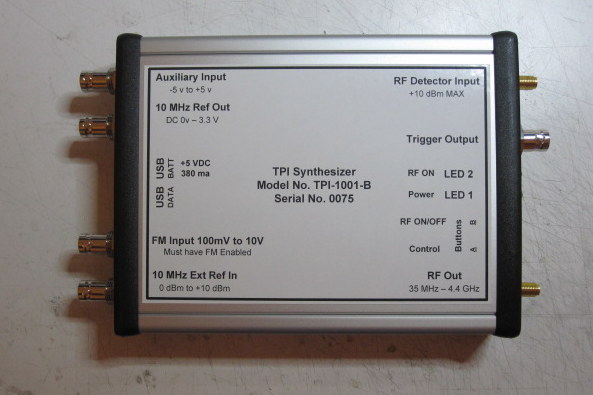
Internal Reference is 10MHz Temperature Compensated Clock Oscillator at +/-1.5 ppm over temperature.
External Reference Input is -10 – +13 dBm 50 ohm. Any standard 10MHz reference will work.
10MHz Reference Output available at back panel. The Reference is accessed via a BNC connector (New Metal Connectors). The output will drive a 50 ohm coaxial cable. DC Coupled 0v to 3.3v
The unit has been *calibrated and the RF Output Power is accurate within +/-1dBm with 90% of all readings within 0.6dB of reported power 35MHz to 4GHz.
Output Power is available from +10dBm to -80dBm for most frequencies (90dB linear range) See User Manual.
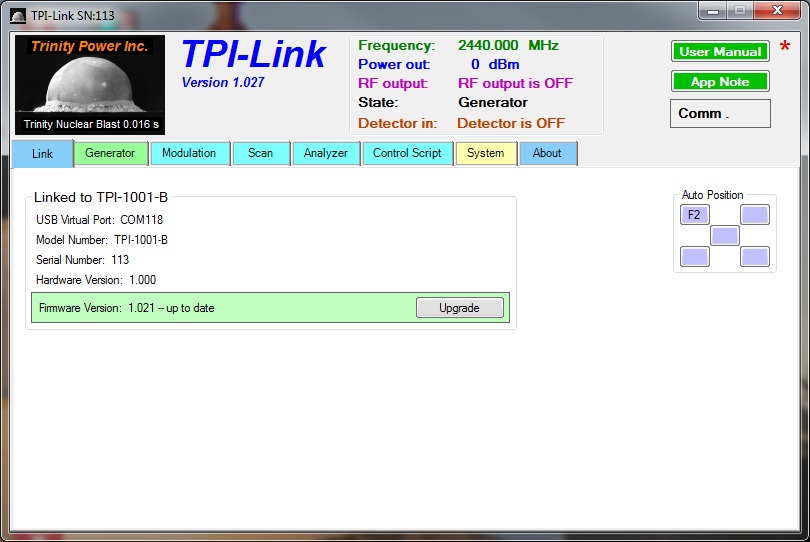
TPI-Link is the heart of this project. We are always improving and adding features to the
software and we have a public link where we are always updating the software and
adding documentation. The software works perfectly and most upgrades come as a
result of user recommendations.
Generator Tab:

You can have up to 6 presets. You can power down the internal VCO or not. There is a 10MHz
Reference output that can be on or off.
Modulation Tab:
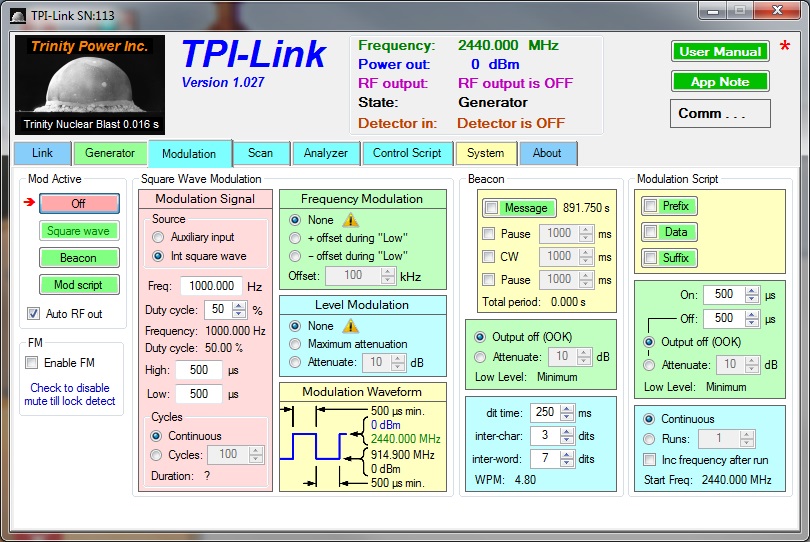
Modulation Features: FM / OOK / Morse Code and Beacon
Please download the Product description for more information regarding all that you can do
with the modulation tab, or send me an email and I have an app-note available.
robert@rf-consultant.com
Scan Tab:
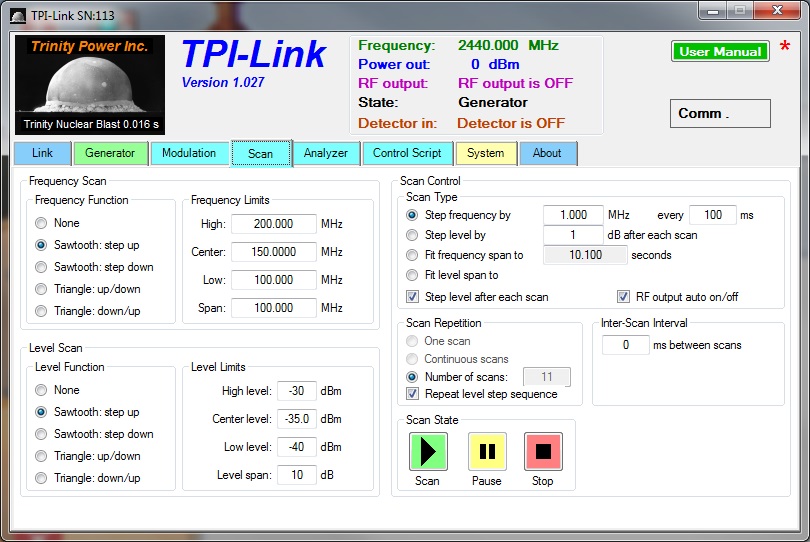
Please download the Product description for more information regarding all that you can do
with the Scan tab.
Analyzer Tab:
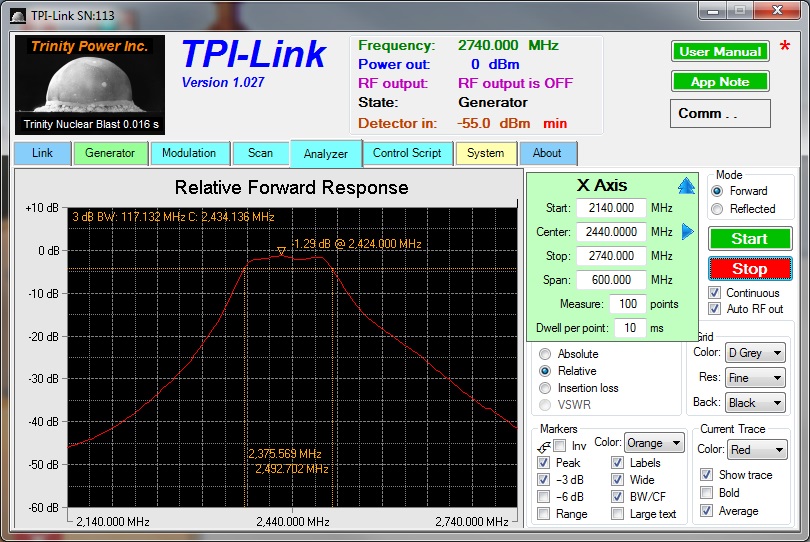
This is a plot of a 3pole BPF. I zeroed out my cables by running “Absolute” and then selected
“relative” and this plot emulates exactly what my expensive HP S Parameter Test Set shows.
The RF Detector has around 65dB of calibrated range from +10dBm to -55dBm for most frequencies. It is within 1dB accurate.
You can add your own directional coupler and measure return loss:
I have an excellent app-note for these features: robert@rf-consultant.com
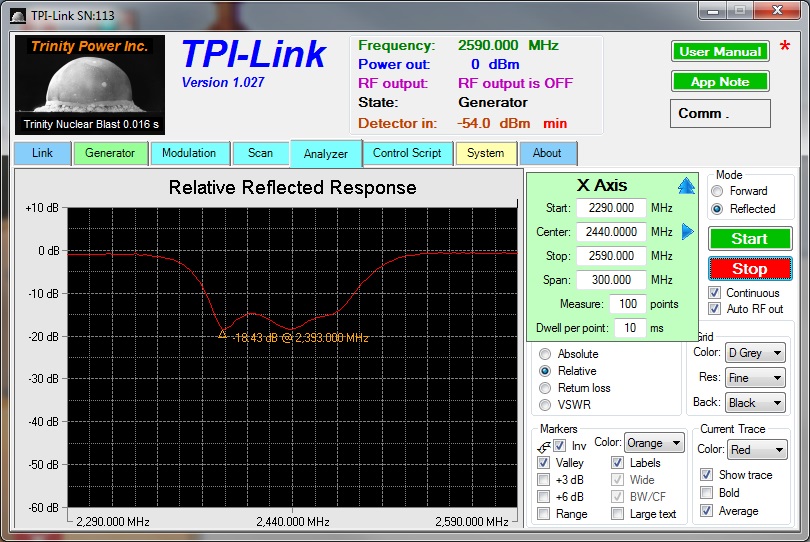
For example this is the return loss for the same 2440MHz BPF measured above. You can also measure this as VSWR.
There are many options for recording data. Outputs can be PNG, JPEG, CSV and more.
Script Tab:
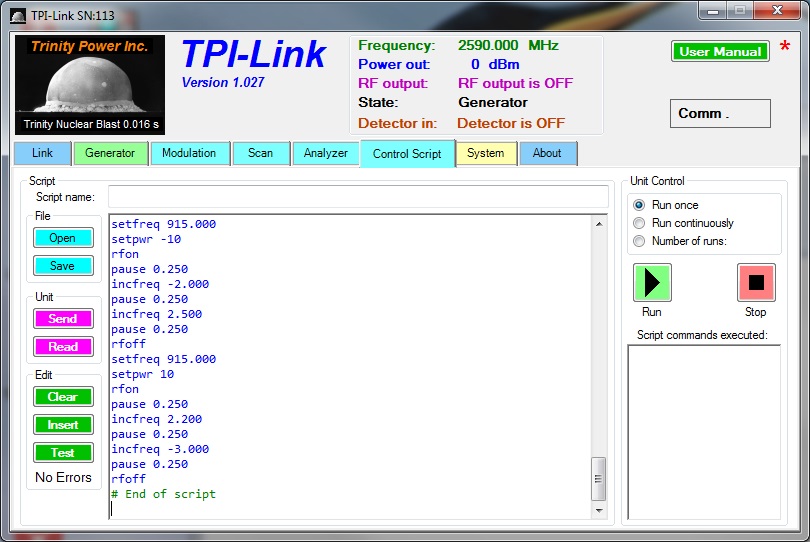
You can write your own test sequences and store that test script to on board memory.
This allows you to release from the laptop and supply the unit with a 5V source
(USB Power Bank for example).
Walk around anywhere and push a button and your test sequence will run.
System Tab:
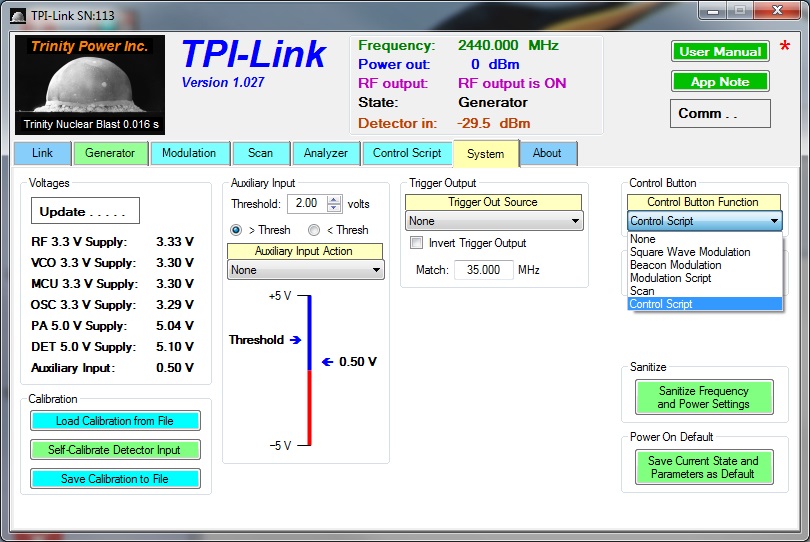
The “System” tab has a rich set of features. The unit has an “auxiliary” port (BNC) that can
be configured for many functions. The unit also has an output “Trigger” source with 14
trigger events and options. There are two buttons that can be utilized to control the unit.
One button simply turns the RF on and off (which can be done with the mouse control
as well). The second button is the “Control Button” and that button can be configured as well.
Packaged in extruded Aluminum housing with Aluminum End Plates. (I have designed some Band Pass Filters and Low Pass Filters. Let me know if you need something specific.)
This package includes a CD with drivers and an executable file that will install and run on a PC with Windows 7 , Windows 8 and Windows 10 (USB cable included).
MCU/SOFTWARE:
An Atmel microcontroller (MCU) is used to communicate with the synthesizer, the attenuators, and various other devices within the unit. The MCU also facilitates communication with the host PC via a USB connection. When the unit receives power, the MCU configures the hardware to the state last saved within TPI Link. In this way, the TPI-1001-B can operate stand-alone as a fixed frequency signal generator, a scanner, a modulated signal generator, a radio beacon, or can run a stored script. TPI Link is used to control the unit in real-time and to configure the power up state of the unit.
Future software upgrades for both TPI Link and the MCU’s firmware can be distributed as a single PC application, a new version of TPI Link, which has the MCU’s firmware embedded within it. TPI Link can upload the new firmware directly to the unit without the need for any other programs or hardware.
The GUI, TPI Link, runs on a PC and communicates with the unit via the USB port. TPI Link can completely configure and operate the unit. The unit’s configuration can be saved in nonvolatile (persistent) memory in the unit for use each time the unit is powered. For this reason TPI Link does not necessarily have to be running whenever the unit is in use, but it facilitates many real-time activities and can monitor the various power supplies in the unit.
A very informative “Help” feature is included that describes most of the features found in the TPI-1001-B Signal Generator. *calibrated against a calibrated signal generator and spectrum analyzer with cable losses determined.

Today’s Price is $395.00 USD
